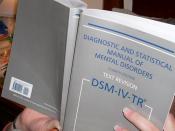Imagine, not being able to find the strength to get out of bed for more than four hours in a day. A dark room is heaven, simple activities cause exhaustion and no amount of bed rest can be sufficient, fatigue is always eminent. One may think perhaps it is the flu, but after having been stricken with the flu before, this time seems different. Along with the physical pain and general sick feeling, psychological and neurological problems join the pain, becoming a problem many people have heralded the "immune disease of the nineties." Chronic Fatigue and Immune Dysfunction Syndrome (CFIDS) has exploded as an epidemic in the past 10-15 years. The time span here is very important in that the disease has gained itself yet another name; Yuppie Flu. This may have to do with the fact that many young, hard-working people have begun to feel the ravages of CFIDS.
Through many studies, CFIDS has also earned an array of other names: chronic mononucleosis-like syndrome, chronic Epstein - Barr virus syndrome, post viral fatigue syndrome, post infectious neuromyasthenia, Iceland Disease, and Royal Free Hospital Disease, among others. The cluster of names (some of which are inaccurate) has come from a cloud of confusion surrounding the disorder. Although the disease was formally defined in 1988 by a consensus panel convened by the Centers for Disease Control (CDC), the results and symptoms the panel listed for easier diagnoses has been controversial. Symptoms vary widely from patient to patient which gives some doctors reason to believe that there are problems with the CDC definition. Many critics of the disease argue that it is a non-disease, and is in fact "...a misnomer for several well known psychiatric disorders including hysteria, anxiety, and depression." (Michael Rosenbaum M.D. Solving the Puzzle of Chronic Fatigue Syndrome)...



Very good!
I enjoyed reading this essay very thoroughly. It will come in handy when I begin studying this for my psych class!
2 out of 2 people found this comment useful.